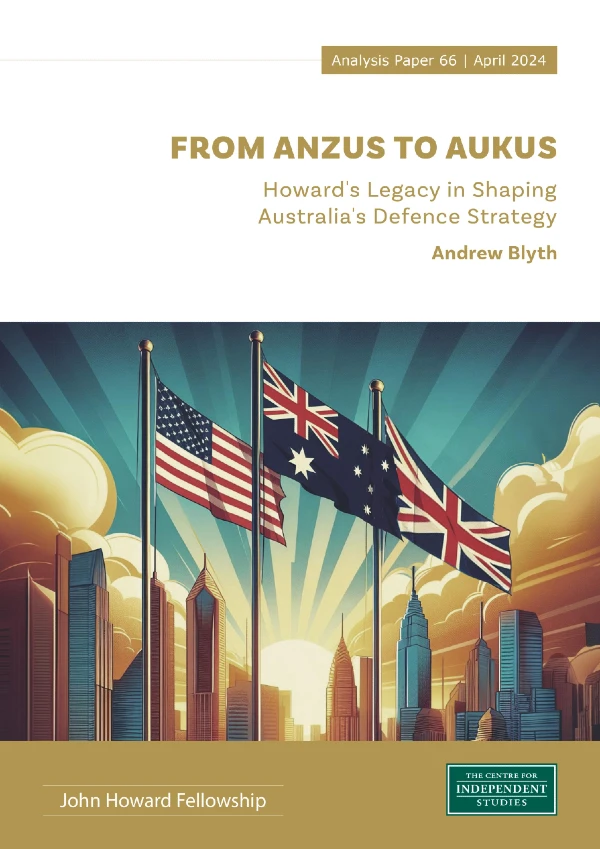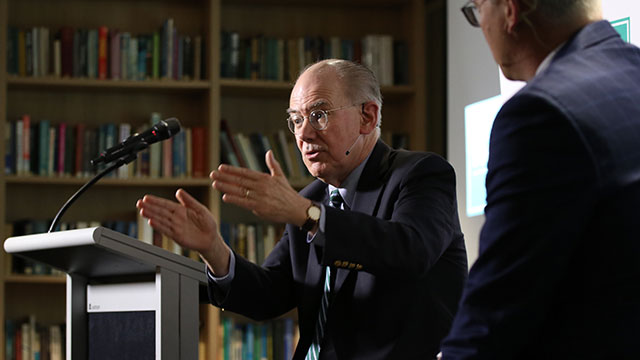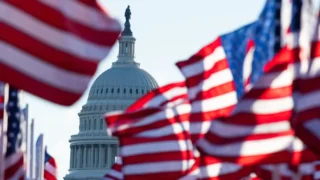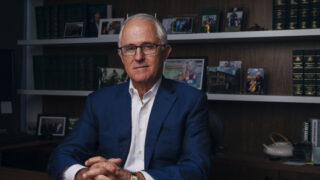

The transition from the foundational ANZUS Treaty to the innovative AUKUS partnership signifies a watershed in Australia’s defence policy and strategic direction; a transformation that owes much to the military and national security leadership of John Howard.
Under Howard’s tenure as Australia’s 25th and second-longest serving prime minister, Australia navigated through a period of significant global and regional changes — adapting its defence strategy to meet emerging security challenges. This period was characterised by Howard’s active engagement with our key allies and a keen focus on enhancing Australia’s military capabilities and strategic autonomy.
His efforts laid the groundwork for Australia’s future defence policies, including the eventual shift towards more advanced technological cooperation and intelligence-sharing exemplified by AUKUS. Howard’s influence extended beyond immediate policy decisions, embedding a strategic vision that has continued to shape Australia’s defence orientation and its approach to international partnerships.
Through this lens, the progression to AUKUS can be seen not just as a policy shift, but as the culmination of years of strategic evolution, deeply influenced by Howard’s leadership and his commitment to securing Australia’s interests in a rapidly changing world — leaving an indelible mark on the nation’s military and diplomatic posture.
This paper explores Howard’s enduring legacy, examining how his tenure laid the foundational principles that would guide Australia from traditional security arrangements to the innovative and technologically advanced partnership of AUKUS. Through a detailed analysis of Howard’s policies and initiatives, this paper uncovers the strategic threads that connect ANZUS to AUKUS.
Seed sowing
The seeds of the AUKUS partnership can be traced back to the early 2000s, epitomised by the special relationship between John Howard and former United States President George W. Bush.[1] This period marks a significant alignment of political and strategic interests between Australia and the US, characterised by mutual trust and cooperation.[2] Howard and Bush’s close rapport laid the groundwork for unparalleled collaboration in defence, intelligence, and security matters, setting a precedent for future alliances.[3]
Their joint efforts in addressing global security challenges, including terrorism and regional conflicts, underscored the potential for future partnerships to shape international security dynamics. This historical backdrop played a crucial role in paving the way for the AUKUS agreement.
Howard in Washington
The bonds between Australia and the United States are profoundly entrenched; encompassing a wide spectrum of cooperation spanning diplomatic, defence, economic, and cultural realms. These ties have been forged for well over a century, anchored in shared values of democracy, freedom, and a commitment to peace and security in the global arena.[4] Notably, Australian troops have stood shoulder to shoulder with Americans in every significant military engagement since World War I, demonstrating our unwavering solidarity and commitment.
On September 10, 2001, John Howard and George W. Bush met at the Naval Shipyard in Washington DC to celebrate the 50th anniversary of the Pacific Security Treaty (better known as the ANZUS Treaty).[5] The alliance of our two nations was formalised through the ANZUS Treaty in 1951 — an Australian initiative proclaimed by the Menzies Government[6] — marking the beginning of what would evolve from a collective trilateral security arrangement into a profound partnership. This celebration (preceded by an informal event at the Australian Ambassador’s residence the evening before) marking five decades of close military and strategic cooperation between Australia and the United States, was overshadowed by the catastrophic events that would unfold the very next day. With one eye to the future, on the afternoon of September 10, Howard canvassed with Bush and his senior advisers the merits of a free trade agreement between Australia and the United States — an agreement that was negotiated in ‘quick time’ coming into effect on 1 January 2005.[7]
In commemorating the 50th anniversary of the ANZUS Treaty in front of political and military dignitaries, Howard and Bush not only celebrated a historical milestone but also reaffirmed the values and commitments that would guide the Australia-US alliance through new and unforeseen challenges.[8] Bush spoke of Australia’s hard-earned reputation “as a strategic and economic ally” of the US[9] while Howard stated:
“…our two nations and our two societies have demonstrated to the world that values based on freedom and individual liberty in the end win acceptance. But they only win acceptance if behind the commitment is a determination on the part of nations who believe in those values to defend them, if necessary fight for them, and always be ready to repel those who would seek to take those freedoms away.”[10]
Howard was clear that defending freedom and individual liberty demands continuing vigilance, and a willingness to respond to any threats against these principles. The world would change forever the next day.
September 11
On September 11, 2001, terrorist attacks — on the World Trade Centre in New York City and the Pentagon in Washington, D.C. — dramatically changed the global security landscape, marking a pivotal moment in world history and in the Australia-U.S. alliance under the ANZUS Treaty.
The attacks on 9/11 — an “epoch changing event”[11] — served as a stark reminder of the evolving nature of security threats early in the 21st century, and they played a significant role in reinforcing the bonds between Australia and the United States. In a letter to the President, Howard conveyed his profound dismay at the appalling events and the tragic loss of innocent lives, stating:
“The Australian Government and people share the sense of horror experienced by your nation at today’s catastrophic events and the appalling loss of life. I feel the tragedy even more keenly, being here in Washington at the moment. In the face of an attack of this magnitude, words are always inadequate in conveying sympathy and support. You can however be assured of Australia’s resolute solidarity with the American people at this most tragic time. My personal thoughts and prayers are very much with those left grieved by these despicable attacks upon the American people and the American nation.”[12]
In response to the horrific attacks, Howard (while flying back to Australia) in discussions with US Ambassador to Australia, Tom Schieffer, and Foreign Minister, Alexander Downer, invoked Article IV of the ANZUS Treaty[13] (on 14 September) — for the first time in its history. This action signifying Australia’s unwavering support for the United States and committing to assisting in any retaliation.[14] Australia’s response mirrored “NATO’s invocation of its mutual defence provision”, Australian academic Professor Michael Wesley observed.[15]
Howard’s decision underscored the depth of the Australia-U.S. alliance and showcased Australia’s commitment to stand with the United States in the face of global terrorism — a testament to the strength and resilience of the partnership celebrated a day prior to the attacks.
Turning Point
This moment of solidarity marked a turning point in Howard’s leadership and in the strategic orientation of Australia’s defence policy. Howard knew the fight against terrorism would last well into the future and that Australia was ‘not immune from a terrorist attack.’[16]
The terrorist attacks catalysed a shift towards a more active role in global counter-terrorism efforts and set the stage for Australia’s (along with the United Kingdom under Labour’s prime minister Tony Blair) involvement in the United States-led military operations in Afghanistan (2001) and later as part of the ‘coalition of the willing’ in Iraq (2003).
Australia committed some 1500 troops to the US-led war against the Taliban in 2001; 2000 troops to the Iraq campaign in 2003 (together with frigates and fighter aircraft in the Gulf).[17] While modest in size, these decisions reflected Howard’s view that Australia’s security could best be ensured through “undeviating support” for, and a strong and active alliance with, the United States — a principle that would guide Australia’s strategic decisions and defence policies into the future.[18] Addressing the nation on the day hostilities commenced in Iraq, Howard underlined the alliance dimensions of his government’s decision:
“There’s also another reason and that is our close security alliance with the United States. The Americans have helped us in the past and the United States is very important to Australia’s long-term security. It is critical that we maintain the involvement of the United States in our own region, where, at present, there are real concerns about the dangerous behaviour of North Korea. The relationship between our two countries will grow more rather than less important as they years go by. A key element of our close friendship with the US and indeed with the British is our full and intimate sharing of intelligence material. In the difficult fight against the new menace of international terrorism there is nothing more crucial than timely and accurate intelligence. This is a priceless component of our relationship with our two very close allies. There is nothing comparable to be found in any other relationship — nothing more relevant indeed to the challenges of the contemporary world.”[19]
Howard later reflected that the decision to join American and British forces in the military operation against Saddam Hussein in March 2003 was the “most controversial foreign affairs action” of his government but that his attitude towards the invasion “had not changed.”[20]
Bush in Canberra
In a significant recognition of the lasting alliance between the United States and Australia, Bush’s address to a joint session of the Australian Parliament on October 23, 2003, underscored the distinctive and strategic bond shared by our two countries, particularly in the context of the Asia-Pacific region.
By emphasising the importance of a forward presence in Asia and the need for nations to actively contribute to their collective security, Bush articulated a vision of partnership:
“Our nations have a special relationship throughout the Pacific to help keep the peace, to ensure the free movement of people and capital and information, and advance the ideals of democracy and freedom. America will continue to maintain a forward presence in Asia, continue to work closely with Australia. Security in the Asia Pacific region will always depend on the willingness of nations to take responsibility for the neighbourhood, as Australia is doing. By your principled actions, Australia is leading the way to peace in Southeast Asia. And America is grateful.”[21]
Howard responded in kind:
“The President of the United States and I first met face-to-face on 10 September 2001. As we celebrated at the naval dockyard in Washington the shared partnership of the ANZUS alliance neither of us knew what lay ahead. The next day the world did change, and we saw arising out of those events the character and the strength and the leadership of the man we welcome today. George Bush, the 43rd President of the United States, rallied his own people and the people of the world in the fight against terrorism. He reminded us then, as we should be reminded today, that terrorists oppose nations such as the United States and Australia not because of what we have done but because of who we are and because of the values that we hold in common.”[22]
The decision to go to war was a calculated weighing to advance Australia’s national interests. Howard committed Australian troops on the theory of locating and destroying Iraq’s weapons of mass destruction (WMDs) — a theory accepted by most Australians including Labor’s Kevin Rudd as well as US senator Hiliary Clinton and UK prime minister Tony Blair. The passage of time reveals the “government had lied to the Australian people and it had deployed the Australian Defence Force (ADF) on the basis of lies;”[23] and actions were based on a ‘cover story’ for the United States’ foremost objective: regime change.[24]
According to Albert Palazzo, a former director of war studies in the Australian Army Research Centre, Australia’s aim as a member of the ‘coalition of the willing’ was as equally ambitious:
“Howard’s objective was to use the war to enhance the nation’s standing with the United States. Improving the alliance was the main goal. The war’s centre of gravity was not Baghdad or even Saddam Hussein…it was the Bush administration’s leadership in Washington and the relations between the two countries.”[25]
While Australia’s contribution is considered “small” and its absence “would not have been noticed” our willingness to join the fight in the Middle East was central to the United States’ need for international legitimacy in “its use of force against another sovereign state.”[26]
Australia’s willingness to offer its name, standing and reputation showed again its dependency on the United States, trusting in the great-power alliance, and outweighing all other considerations, “even moral ones” to earn its security in the Asia-Pacific.[27]
The decision to commit Australian personnel by Howard was not taken lightly nor on a whim. Howard did not act alone.
“Accountability for the advice and the assessments provided by the substantial defence and security machinery of the Commonwealth Government needs to be distributed broadly, as the 2004 report by former diplomat and intelligence chief Phillip Flood made clear.”[28]
The overwhelming fear of being abandoned and losing the protection of a great power was real: “Australia remained an uncritical supporter of the American narrative.”[29] As a result of its participation, “Australia’s political stock in Washington reached an all-time high. Washington was pleased to have Australia by its side. Howard achieved his aim of strengthening the alliance”.[30]
Howard’s personal regard for Bush persisted throughout the remainder of his parliamentary term (and continued after he left office in 2007). His oft-celebration of the two nations’ “shared history, values and security interests”[31] throughout his prime ministership did not go unnoticed or unappreciated by Bush nor the American people.
The ‘Man of Steel’ (Howard) was awarded the Presidential Medal of Freedom by Bush in January 2009 for being a “faithful steward of alliances” and for “standing by your mates.”[32] Australia was now wedded to the United States.
Bilateral relations with China
John Howard’s hosting of Chinese President Hu Jintao at Parliament House on 24 October 2003, just one day after welcoming President Bush, was a pivotal moment. Hu’s address celebrated as a “landmark event in the history of Australia-China relations,’”[37] laid the groundwork for a new and complex chapter in the bilateral relationship between Australia and China. While Hu extolled the virtues of “all-round cooperation” between China and Australia, his stipulation that Australia recognise Taiwan as “an inalienable part of Chinese territory”[38] — and oppose Taiwanese independence forces — underscored the complexities and conditional nature of this partnership moving forward.
Howard’s decision to invite Hu to address the Parliament was a calculated strategic move. Just a year prior, Howard had been instrumental in clinching a multi-billion, decades-long deal to supply China with three million tonnes of liquefied natural gas over a generation.[39] Viewing Hu’s visit as a pivotal opportunity, Howard aimed to strengthen ties and position China as a key regional trading partner alongside the United States, “telling the world it was possible, simultaneously, to have close relations with both the United States and China.”[40] In his remarks to the Parliament, Howard maintained an optimistic and confident tone that:
“the relationship between Australia, the United States and China respectively on a two-way basis our relationship with the United States and then again our relationship with China will be extremely important to the stability of our region. Our aim is to see calm and constructive dialogue between the United States and China on those issues which might potentially cause tension between them and it will be Australia’s aim as a nation which has different, but nonetheless close relationships with both of those nations to promote that constructive and calm dialogue.”[41]
The uniqueness of the occasion and the political symbolism of building a “friendly, pragmatic association with the Chinese”[42] underscored Howard’s budding credentials “as an effective and dominant foreign policy prime minister.”[43]
AUKUS — a new strategic chapter
On September 15, 2021, a landmark event unfolded as the heads of three leading liberal democracies — spanning the strategic expanse of the Asia-Indo-Pacific regions — convened in a pioneering hybrid news conference. This pivotal moment marked the public unveiling of AUKUS; a freshly-minted strategic alliance signalling a new chapter in international diplomacy and security cooperation.
Central to these initiatives were the contributions of Scott Morrison, Australia’s 30th Prime Minister, Boris Johnson, the United Kingdom’s 75th Prime Minister, and Joe Biden, the 46th President of the United States. Their months-long collaboration was instrumental in establishing a partnership designed to strengthen defence mechanisms, advance security infrastructures, and promote a more profound cooperative approach towards mutual interests in the Asia-Indo-Pacific regions.
The joint leaders’ statement outlined that the aim of AUKUS was to “strengthen the ability of each to support our security and defence interests, building on our longstanding and ongoing bilateral ties.”[44] In advocating for Australia’s national interest in joining AUKUS, Morrison stated:
“Since 2016 our strategic environment has become more challenging. The Indo-Pacific is now the centre of strategic competition. This has compelled a re-assessment of the capabilities Australia needs to meet the changed threat environment over the long term. AUKUS is a key part of the response, but it is not a new defence alliance or pact. It is a change in capability, not a change in strategy. ASEAN will remain central to Australia’s engagement in our immediate region. Australia is as committed as ever to our established and valued partnerships, including the Five Eyes.”[45]
Commentators greeted the AUKUS announcement as being “a truly momentous decision,” “a game-changing move,” “a sign of a new global order,” and “perhaps the most significant capability collaboration in the world anywhere in the past six decades.”[46] At its very essence, AUKUS is dedicated to safeguarding freedom and democracy against the backdrop of managing intricate relationships with China, a potent geopolitical rival and crucial trading partner.[47] This security pact represents a strategic endeavour to uphold these essential values while navigating the delicate intricacies of international diplomacy and economic interdependence.
AUKUS – Pillar 1
At the heart of the AUKUS agreement is a two-stage trilateral effort for the purchase of three (and up to five) US Virginia class nuclear submarines to be delivered to Australia in the early 2030s; and, to support Australia to acquire between six and eight conventionally armed, nuclear-powered submarines built and operated by both Australia and the United Kingdom based on next generation design.[48] (For Scott Morrison, AUKUS aided the cancellation of the problematic $90 billion contract with France for 12 conventionally-powered submarines to replace the aging Collins-class boats.[49])
According to the UK government, the first SSN-AUKUS for the Royal Navy will commence construction as early as the late 2020s and be operational by the late 2030s. Notably, Australia will begin building its first SSN-AUKUS in Adelaide by the end of this decade and is expected to see delivery in the early 2040s.[50] Australia will be one of only seven members of an exclusive club equipped with nuclear-powered submarines,[51] and only the second country to receive such capability from the US.[52] To encourage a culture of personnel exchange and training opportunities, the US and UK will also initiate a rotational presence (known as the Submarine Rotational Force-West) as early as 2027 at HMAS Stirling in Western Australia; involving a rotation of one UK Astute class SSN and up to four US Virgina class SSNs.[53]
Among professional analysts of international relations and foreign policy, opinion on AUKUS (Pillar 1) is equal parts alarmed and sanguine . While Australian strategic studies expert Hugh White (a supporter of submarines) sees this multi-decade defence procurement initiative as “the most challenging and intricate engineering endeavour Australia has ever embarked on” he is not shy in calling AUKUS, “the most disastrous defence-policy mistake in our history.[54] On the other hand, John Blaxland, former Australian soldier and now professor (a colleague of White) sees this unprecedented and historical project as a ‘game-changer’ for Australia’s defence landscape.[55] On the political front, former treasurer and ambassador to the US, Joe Hockey, sees the agreement as representing a new era akin to ‘ANZUS 2.0’. In a similar vein, Kim Beazley, former deputy prime minister and ambassador to the US, interpreted the pact as the dawn of “a new phase in the Alliance”, signalling a deepening of strategic ties and collaboration. Anthony Albanese, then-Opposition leader (briefed a day in advance), extended a conditional response towards AUKUS. His stance evolved significantly after assuming office, where he stood in solidarity at an event in San Diego with international counterparts, US President Joe Biden and UK Prime Minister Rishi Sunak (who had replaced Boris Johnson), championing the AUKUS agreement as a cornerstone for fortifying Australia’s national security.[56]
The AUKUS partnership, while initially highlighted for its focus on providing Australia with nuclear-powered submarines, represents a far broader and more ambitious undertaking — aimed at enhancing the collective defence posture and strategic capabilities of Australia, the United Kingdom, and the United States within the Indo-Pacific region. This initiative is not merely about augmenting naval power; it encompasses a comprehensive effort to strengthen diplomatic ties, bolster security frameworks, and forge a more integrated approach to defence and technological collaboration among the three nations. Much work is to be done.
AUKUS – Pillar 2
The AUKUS agreement signifies a strategic leap forward, offering Australia a direct route to enhanced warfighting capabilities. However, AUKUS’s ambit extends beyond the mere provision of submarines; it is poised to profoundly elevate diplomatic, security, and defence cooperation throughout the Indo-Pacific.[57]
Critical to the AUKUS agreement is the commitment to deepening information and technology sharing — Pillar 2.[58] This expansion encompasses a wider exchange of information and technology and promotes deeper integration of security and defence-related science and technology initiatives. This aspect of the partnership goes beyond traditional intelligence exchange; aiming to facilitate access to cutting-edge technologies and innovations that can significantly enhance military and security capabilities. The focus is on creating a framework that allows seamless sharing of critical technological insights and advancements, thereby ensuring all three countries benefit from the latest developments in defence technology.
Moreover, AUKUS is dedicated to the integration of security and defence-related science and technology. This involves collaborative research and development efforts in areas such as artificial intelligence, quantum computing, undersea warfare, and cyber defence — involving universities and industry in each nation.
By pooling resources, expertise, and research capabilities, the partnership seeks to accelerate technological advancements and create synergies that would be challenging to achieve independently. This collaborative approach is expected to lead to breakthroughs that can provide a strategic edge in a rapidly evolving global security environment.[59]
AUKUS represents a multifaceted strategy aimed at securing a more stable, secure, and prosperous Indo-Pacific region. Through enhanced diplomatic engagement, technological collaboration, and military interoperability, the partnership seeks to address contemporary challenges and shape the future security landscape. The successful realisation of AUKUS’s ambitious goals will require not just technological innovation and strategic foresight but also a deep commitment to collaboration and mutual support among its member nations. Achieving success requires action that is louder than words and the strengthening of the Australia-UK Defence partnership underpins, in part, the success of AUKUS.
Strengthening Ties: Australia-UK Defence Partnership
The bond between Australia and its longstanding trading partner, the United Kingdom, is both strong and deep-rooted. Anchored in a shared military and democratic legacy, our nations uphold an alignment across foreign policy, defence, security, intelligence, and trade and economic affairs. As partners in the Five Eyes intelligence alliance[60] (along with the US, Canada, and New Zealand), both countries share a unified vision towards achieving stability, security, and prosperity within the Indo-Pacific region, underscoring the importance of this goal to our UK counterparts. This partnership exemplifies a commitment to mutual interests and a concerted effort to address regional and global challenges together.[61]
Indo-Pacific Tilt
Since Brexit was formalised on 31 January 2020, the Conservative governments of Johnson (2019-2022), Liz Truss (2022) and Rishi Sunak (2022-) have steered the United Kingdom’s focus back to the Indo-Pacific. This “evolutionary step…against the backdrop of a more volatile and contested world” has “instigated a record investment in defence and a more active and activist posture for Britain on the world stage.”[62] For current prime minister, Sunak, the dominant defence aspect of the UK’s ‘Indo-Pacific tilt’ is centred on “deepening our bilateral political, economic and security relations across the region” in readiness for a “difficult and most dangerous” decade ahead. Sunak was clear on the reason for the ‘tilt’:
“China poses an epoch-defining challenge to the type of international order we want to see, both in terms of security and values — and so our approach must evolve. We will work with our partners to engage with Beijing on issues such as climate change. But where there are attempts by the Chinese Communist Party to coerce or create dependencies, we will work closely with others to push back against them. And we are taking new action to protect ourselves, our democracy and our economy at home.”
Building on this foundation, the advent of the AUKUS partnership further cements the strategic ties between Australia and the UK, extending our collaboration into new realms of defence technology and cybersecurity. As stated by then-UK Secretary of State for Defence, Ben Wallace MP:
“The UK has operated nuclear-powered submarines for over sixty years…and throughout that period has collaborated in their development with the US. Choosing to open up this collaboration to Australia is a seismic shift and a demonstration of the UK’s and US’s trust in Australia as a partner and our collective desire for it to have the tools it requires to meet with the [Indo-Pacific] challenges ahead.”[63]
This trilateral agreement represents a step forward in renewed joint military capabilities; emphasising the development of cutting-edge technologies — not limited to nuclear-powered submarines, but also advanced cyber defences. Australia and the United Kingdom are not only reinforcing historical ties but also enhancing security cooperation and strategic interdependence in an increasingly complex international landscape.
Addressing an Australian audience in December of last year, former UK prime minister Boris Johnson articulated his perspective with clarity, emphasising the necessity of AUKUS not solely for the creation of a new generation of submarines but also for fostering a broader collaboration:
“We need AUKUS…not just in building the new generation of submarines … but developing the whole second pillar of AUKUS, the sharing of technology, of AI (artificial intelligence), on quantum, on semiconductors.”[64]
Johnson’s remarks point towards a future where technological innovation and strategic partnership play critical roles in shaping global security dynamics.
AUKUS — strategic autonomy
Beyond the technical aspects, the AUKUS partnership has ignited discussions about Australia’s strategic autonomy. While the alliance significantly enhances Australia’s defence capabilities, it also deepens its strategic dependence on the US and UK.
The partnership, while primarily focused on bolstering military capabilities and technological advancements, has sparked an important conversation about Australia’s strategic autonomy. By enhancing Australia’s defence infrastructure through access to nuclear-powered submarines and other advanced technologies, this alliance undeniably strengthens Australia’s military position. However, it simultaneously raises questions about the degree to which Australia’s security and foreign policy decisions are becoming intertwined with — and becoming possibly more dependent on — the strategic interests and directives of our two partners.
This dependence is not merely a matter of military hardware; it extends into the realms of intelligence sharing, cyber security, and technological research and development. The collaboration could be seen as a double-edged sword. On one side, it offers Australia a fast track to modernising its military and gaining a technological edge in the Indo-Pacific region. On the other, it could constrain Australia’s ability to make independent strategic decisions that align with its national interests but may diverge from those of its more powerful allies.
For US Naval War College professor, Jonathan Caverley, AUKUS represents such a monumental commitment that it indicates Australia’s “complete reliance on the US for security.” He argues that Australia has “forgone both financial resources and intermediate-term capabilities in favour of strengthened ties with the US, suggesting that Australia is positioned to either stand alone or be locked into the distinctive American approach to the Indo-Pacific region and the Sino-American competition.”[65] This nuanced perspective underscores the critical trade-offs inherent in deepening defence collaborations and the potential implications for Australia’s strategic autonomy and its role in regional dynamics.
The notion of strategic autonomy is crucial for a nation’s ability to navigate global politics and protect its interests. For Australia, which is geographically positioned in a region of growing strategic competition — particularly with China’s rise — the ability to maintain a balanced and independent foreign policy is paramount. The AUKUS partnership brings to the fore the delicate balance Australia must strike between leveraging the benefits of its alliances and maintaining the capacity to act independently in a rapidly changing geopolitical landscape. This is no easy task for our elected representatives.
A legacy of new horizons
Howard’s prime ministership was distinguished by his economic acumen and strategic insight into Australia’s international and defence policies. He emphasised addressing immediate dangers and preparing for future challenges through strong alliances. Howard is described as a “military and national security prime minister”[66] whose approach of “pragmatic bilateralism”[67] laid a significant foundation for the AUKUS agreement. His acknowledgement of the crucial role a robust US-Australia partnership holds in maintaining regional and global security cemented his reputation as “our greatest champion of the US alliance.”[68] His active approach positioned Australia as an equal (not a junior) partner in the AUKUS agreement; with Howard’s foresight and commitment to enhancing national security and diplomatic relationships key to Australia’s leading role in AUKUS.
Australia’s engagement with AUKUS marks a pivotal phase in its strategic evolution, poised to significantly enhance its standing in the Indo-Pacific amid a landscape marked by competition and complexity. This journey also unfolds an unparalleled opportunity for Australia to carve a new role on the international stage — leveraging the judgment of its predecessors. Navigating an optimal pathway will inform Australia’s defence posture and its broader influence within the Indo-Pacific region.
The success of the AUKUS alliance critically hinges on robust and impactful leadership spanning a variety of sectors; not just within the government and military spheres. Should AUKUS fail, the impact would go beyond military and strategic issues. As Peter Jennings, a leading Australian authority in strategic policy warns, “if AUKUS breaks, ANZUS breaks.”[69] This warning underscores the profound linkage between the alliances and the potential repercussions for the US-Australia relationship, a subject that will be examined in a forthcoming paper.
The genesis of AUKUS was not a sudden development, but the result of decades of shared strategic interests and evolving security challenges in the region. The AUKUS agreement stands as a testament to the enduring commitment of these three nations to uphold the principles of freedom and democracy in a region undergoing rapid geopolitical shifts and facing escalating security challenges. The agreement not only symbolises a strategic response to the complex dynamics of the Indo-Pacific region but also a testament to Howard’s foresight in anticipating the need for such profound strategic partnerships.
Endnotes
[1] See John Howard, ‘George Bush’ in Lazarus Rising, HarperCollinsPublishers, Sydney, pp. 462-476.
[2] See Donald A. Debats, Tim McDonald & Margaret-Ann Williams, ‘Mr Howard Goes to Washington: September 11, the Australian-American Relationship and Attributes of Leadership’, Australian Journal of Political Science, vol.42, no.2, pp. 231-251, available at: https://doi.org/10.1080/10361140701320000
[3] Joint Press Conference, Prime Minister John Howard and President of the United States, George W. Bush, APEC, Sydney, 5 September 2007, https://pmtranscripts.pmc.gov.au/release/transcript-15569
[4] See 2000 Defence White Paper, https://www.defence.gov.au/about/strategic-planning/defence-white-paper, p.34, accessed 13 March 2024
[5] E.D.L. Killen, ‘The ANZUS Pact and Pacific Security’, Far Eastern Survey, vol.21, no.14, available at: https://www.jstor.org/stable/3024627
[6] See a paper written by Commander Andrew Brown, Royal Australian Navy: https://www.navy.gov.au/history/feature-histories/history-radford-collins-agreement
[7] Howard, Lazarus Rising, p. 377; the AUSFTA was negotiated and signed in ‘quick time’ according to Owen Harries and Tom Switzer in ‘Loyal to a Fault’, The American Interest, available at: https://www.the-american-interest.com/2006/06/01/loyal-to-a-fault/
[8] According to a Brookings Institution report released in 2010, of the 63 major alliances over the past 500 years only ten of those partnerships have lasted for forty years or longer, two of these include NATO and ANZUS: https://securityanddefenceplus.plusalliance.org/essays/delivering-aukus-success-in-challenging-times/
[9] President George W. Bush remarks, Washington Navy Yard, Washington DC, 10 September 2001, https://georgewbush-whitehouse.archives.gov/news/releases/2001/09/20010910-1.html
[10] https://georgewbush-whitehouse.archives.gov/news/releases/2001/09/20010910-1.html
[11] Paul Kelly, ‘Howard’s decade: An Australian Foreign Policy Appraisal’, Lowy Institute Paper No. 15, 2006, p.16, available at: https://www.lowyinstitute.org/sites/default/files/pubfiles/Kelly%2C_Howard%27s_decade_1.pdf
[12] John Howard, Lazarus Rising, HarperCollins, Sydney, 2010, p. 381
[13] Article IV of the ANZUS Treaty states: “Each Party recognizes that an armed attack in the Pacific Area on any of the Parties would be dangerous to its own peace and safety and declares that it would act to meet the common danger in accordance with its constitutional processes. Any such armed attack and all measures taken as a result thereof shall be immediately reported to the Security Council of the United Nations. Such measures shall be terminated when the Security Council has taken the measures necessary to restore and maintain
international peace and security.”, available at: https://www.aph.gov.au/~/media/wopapub/house/committee/jfadt/usrelations/report/appendixb_pdf.ashx, p.109.
[14] Howard, Lazarus Rising, pp. 385-386.
[15] See Michael Wesley, ‘Perspectives on Australian foreign policy, 2001’, Australian Journal of International Affairs, vol. 56, no. 1, 2002, pp. 47-63, available at https://doi.org/10.1080/10357710220120838
[16] Lazarus Rising, p. 385.
[17] See Harries and Switzer, ‘Loyal to a Fault’, The American Interest.
[18] See ‘Australia’s National Security: a Defence Update – 2003, 2005 and 2007’: https://www.aph.gov.au/About_Parliament/Parliamentary_departments/Parliamentary_Library/pubs/rp/rp1516/DefendAust/NationalSecurity
[19] John Howard, Address to the Nation, 20 March 2003, PM Transcripts, available at: https://pmtranscripts.pmc.gov.au/release/transcript-20534
[20] John Howard, Lazarus Rising, HarperCollins Publishing, Sydney, 2010, p.423, p.461.
[21] See President George W. Bush address to a joint sitting of the Australian Parliament, 23 October 2003, available at: https://georgewbush-whitehouse.archives.gov/news/releases/2003/10/print/20031022-12.html
[22] https://australianpolitics.com/2003/10/23/howard-welcomes-bush-to-australian-parliament.html
[23] See Tom Frame, ‘Postscript: appraisals and assessments’ in Tom Frame (ed.), Trials and Transformations, 2001-2004: The Howard Government Volume III, UNSW Press, 2019, p. 357.
[24] See Albert Palazzo’s use of American soldier-scholar Andrew J Bacevich’s term ‘a cover story’ in ‘Iraq and the politics of alliance relationships’ in Tom Frame (ed.), Trials and Transformations, 2001-2004: The Howard Government, Volume III, UNSW Press, 2019, pp. 235-247.
[25] Palazzo, ‘Iraq and the politics of alliance relationships’ p.238.
[26] Palazzo, p.240.
[27] Palazzo, p.241.
[28] Frame, p.358.
[29] Palazzo, p.243.
[30] Palazzo, p.244-247.
[31] Howard, Lazarus Rising, p.498.
[32] https://georgewbush-whitehouse.archives.gov/news/releases/2009/01/20090113-7.html
[33] Palazzo, p.244.
[34] See joint press conference between John Howard and George W. Bush, APEC Australia 2007, 5 September, https://pmtranscripts.pmc.gov.au/release/transcript-15569
[35] See John Howard’s address to the Australian Strategic Policy Institute, Westin Hotel, 18 June 2004, https://pmtranscripts.pmc.gov.au/release/transcript-21325: ‘The ANZUS alliance is an essential pillar of peace, security and prosperity in our region. A secure, stable and prosperous Asia is an abiding national interest of Australia … Australia has no option but to engage with, adapt to, and help to shape a constantly changing security environment. The job of national security is never done. It continues to demand large resources, strategic flexibility and great endurance.’
[36] See Andrew O’Neil, ‘Australia and the ‘Five Eyes’ intelligence network: the perils of an asymmetric alliance’, Australian Journal of International Affairs, vol. 71, no. 5, 2017, pp. 529-543, available at https://doi.org/10.1080/10357718.2017.1342763
[37] https://www.aph.gov.au/About_Parliament/Parliamentary_departments/Parliamentary_Library/pubs/APF/monographs/Within_Chinas_Orbit/Chapterthree
[38] Address by the President of the People’s Republic of China, 24 October 2003, https://parlinfo.aph.gov.au/parlInfo/search/display/display.w3p;query=Id%3A%22chamber%2Fhansardr%2F2003-10-24%2F0006%22;src1=sm1
[39] ‘$25 billion deal a coup for Australia’, The Age, 9 August 2002, https://www.theage.com.au/national/25-billion-deal-a-coup-for-australia-20020809-gduh8t.html
[40] Howard, Lazarus Rising, p.498.
[41] John Howard, Address to the Houses of the Parliament of Australia, House of Representatives, Parliament House, 24 October 2003, PM Transcripts: https://pmtranscripts.pmc.gov.au/release/transcript-20977
[42] Howard, Lazarus Rising, p.498.
[43] https://www.aph.gov.au/About_Parliament/Parliamentary_departments/Parliamentary_Library/pubs/APF/monographs/Within_Chinas_Orbit/Chapterthree
[44] https://www.whitehouse.gov/briefing-room/statements-releases/2023/03/13/joint-leaders-statement-on-aukus-2/
[45] Media Statement, Prime Minister Scott Morrison MP, 16 September 2021, https://www.pm.gov.au/media/joint-leaders-statement-aukus accessed 20 March 2024.
[46] Sam Roggeveen, “How nuclear subs could transform Australia and its alliance in Asia,” The Interpreter, Lowy Institute, 16 September 2021, https://www.lowyinstitute.org/the-interpreter/how-nuclear-subs-could-transform-australia-its-alliance-asia in Jonathan D. Caverley, ‘AUKUS: When naval procurement sets grand strategy’, International Journal, vol.78, no.3, September 2023, pp.327-334, https://doi-org.wwwproxy1.library.unsw.edu.au/10.1177/00207020231195269 , accessed 20 March 2024.
[47] Harries and Switzer, The American Interest.
[48] https://www.navy.gov.au/capabilities/ships-boats-and-submarines/nuclear-powered-submarines
[49] For a fuller discussion see author’s podcast interview with the Hon. Scott Morrison MP, available at: https://open.spotify.com/episode/5zTKkUPBBzcmI4E5clhkx7
[50] ‘The AUKUS Nuclear-Powered Submarine Pathway: A Partnership for the Future’, Crown, 2023, available at: https://assets.publishing.service.gov.uk/government/uploads/system/uploads/attachment_data/file/1142588/The_AUKUS_nuclear_powered_submarine_pathway_a_partnership_for_the_future.pdf p.7
[51] https://www.navy.gov.au/capabilities/ships-boats-and-submarines/nuclear-powered-submarines
[52] Jonathan Caverley, ‘AUKUS: When naval procurement sets grand strategy’, International Journal, vol.78, no.3, September 2023, p.332.
[53] https://www.asa.gov.au/aukus/submarine-rotational-force-west
[54] Hugh White, ‘Fatal Shores’ in Australian Foreign Affairs, Issue 20, February 2024, pp. 6-50.
[55] John Blaxland, ‘Will the AUKUS deal survive in the event of a Trump presidency? All signs point to yes.’, The Conversation website, https://theconversation.com/will-the-aukus-deal-survive-in-the-event-of-a-trump-presidency-all-signs-point-to-yes-225661, accessed 18 March 2024.
[56] https://au.usembassy.gov/aukus-joint-leaders-statement/
[57] ‘AUKUS Briefing Book, December 2023 Update’, Security & Defence PLuS: Arizona State University, King’s College London and UNSW Sydney, p. 11: https://securityanddefenceplus.plusalliance.org/aukus-briefing-book/
[58] See Dr Nadya Bliss, ‘Toward an AUKUS-era research and engineering strategy’, Security & Defence PLuS: https://securityanddefenceplus.plusalliance.org/essays/toward-an-aukus-era-research-and-engineering-strategy/ also discussed with author on ‘Advancing AUKUS’ podcast: https://open.spotify.com/episode/3ylCFWNuGF6KjlN6IoyoqP
[59] For a comprehensive assessment of the challenges in making AUKUS work go to: https://securityanddefenceplus.plusalliance.org/essays/
[60] See ‘2016 Defence White Paper’ for the continuing importance of Australia’s membership of the Five-Eyes intelligence community providing ‘Australia with information superiority and intelligence cooperation that is a vital input into our defence planning’, p.122, available at https://www.defence.gov.au/about/strategic-planning/defence-white-paper , accessed 13 March 2024.
[61] See Stephen Fallon’s Parliamentary Research Paper, ‘Australia’s security relationships’, https://www.aph.gov.au/About_Parliament/Parliamentary_departments/Parliamentary_Library/pubs/BriefingBook47p/AustraliaSecurityRelationships
[62] Integrated Review Refresh 2023: Responding to a more contested and volatile world, UK Government, downloaded at: https://assets.publishing.service.gov.uk/media/641d72f45155a2000c6ad5d5/11857435_NS_IR_Refresh_2023_Supply_AllPages_Revision_7_WEB_PDF.pdf, accessed 2 April 2024, p.2
[63] Foreword by The Rt Hon Ben Wallace MP in ‘The AUKUS Nuclear-Powered Submarine Pathway’, p. 3.
[64] Boris Johnson, 11th John Howard Annual Lecture, Menzies Research Centre, 15 December 2023: https://www.menziesrc.org/news-feed/boris-johnson-delivers-the-11th-john-howard-lecture
[65] Caverley, ‘AUKUS: When naval procurement sets grand strategy’, International Journal, vol.78, no.3, September 2023, p.330.
[66] Paul Kelly assessed Howard as being both a ‘military and national security prime minister’ and ‘response agent’ in ‘Howard’s decade: An Australian Foreign Policy Appraisal’, Lowy Institute Paper No. 15, 2006.
[67] For a more complete description of the character of John Howard’s pragmatic bilateralism see Paul Kelly, ‘Howard’s decade’ and Michael Wesley, The Howard Paradox: Australian diplomacy in Asia, 1996-2006, ABC Books, Sydney, 2007.
[68] Kelly, ‘Howard’s decade: An Australian Foreign Policy Appraisal’, p.16.
[69] See Peter Jennings in ‘ASPI Explains: AUKUS and the submarines’, ASPI podcast, 29 September 2021, https://www.aspi.org.au/video/aspi-explains-aukus-and-submarines









